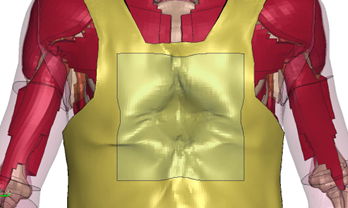Combining protective clothes with human body models for finite element ballistic impact simulations
DOI:
https://doi.org/10.25367/cdatp.2023.4.p141-150Keywords:
Clothes modeling, Finite element modeling, human body models, ballistic impact simulations, injury assessmentAbstract
The ballistic deformation of an ultra-high-molecular-weight (UHMW) polyethylene (PE) composite has been subjected numerically to a multi-layered soft ballistic fabric package modelled upon the body contours of the Global Human Body Models Consortium (GHBMC) human body models M50-P and F05-P. The results of the clothing-body-interaction have been investigated and compared to the behavior of anthropomorphic surrogate models made from ballistic clay. For building the fabric model in donned shape, a single ply of woven fabric material has been converted upon the anthropomorphic body contour by subjecting it to a quasi-deep drawing process. After the fabric deformation, the shaped layer was duplicated 20 times and shifted outwards to build the fabric model, representing a multi-layered soft ballistic fabric package. The results of the ballistic impact simulation show that the response of the human body models (HBMs) is much more compliant than the behavior of the surrogate models. The deformation of the female HBM in terms of penetration depth and diameter of the affected impact region is slightly more severe than the deformation of the male counterpart with respect to identical impact conditions.
References
Untaroiu, C. D.; Pak, W.; Meng, Y.; Schap, J.; Koya, B.; Gayzik, S.: A Finite Element Model of a Midsize Male for Simulating Pedestrian Accidents, Journal of Biomechanical Engineering 2016, 140(1), 011003. DOI: 10.1115/1.4037854.
Grindle, D.; Pak, W.; Guleyupoglu, B.; Koya, B.; Gayzik, S.; Song, E.; Untaroiu, C., A detailed finite element model of a mid-sized male for the investigation of traffic pedestrian accidents. Proceedings of the Institution of Mechanical Engineers, Part H: Journal of Engineering in Medicine 2021, 235(3), 300–313. DOI: 10.1177/0954411920976223.
Iwamoto, M.; Nakahira, Y.: Development and validation of the total HUman model for safety (THUMS) version 5 containing multiple 1D muscles for estimating occupant motions with muscle activation during side impacts. Stapp Car Crash Journal 2015, 59, 53–90, DOI: 10.4271/2015-22-0003.
Roth, S.; Torres, F.; Feuerstein, P.; Thoral-Pierre, K.: Anthropometric dependence of the response of a thorax FE model under high speed loading: validation and real-world accident replication. Computer Methods and Programs in Biomedicine 2013, 110(2), 160–70. DOI: 10.1016/j.cmpb.2012.11.004.
King, M. J.: A Continuum Constitutive Model for the Mechanical Behavior of Woven Fabrics Including Slip and Failure. PhD thesis, Massachusetts Institute of Technology, Cambridge, MA, 2006.
Ivanov, I.; Tabiei, A.: Loosely woven fabric model with viscoelastic crimped fibers for ballistic impact simulations. International Journal for Numerical Methods in Engineering 2004, 61, 1565–1583. DOI: 10.1002/nme.1113.
Shahkarami, A.; Vaziri, R.: A Continuum Shell Finite Element Model for Impact Simulation of Woven Fabrics. Intern. Journal of Impact Engineering 2007, 34(1), 104–119, DOI: 10.1016/j.ijimpeng.2006.06.010.
Ballhause, D.: Diskrete Modellierung des Verformungs- und Versagensverhaltens von Gewebemembranen. PhD thesis, University Stuttgart, 2007.
Boljen, M., Hiermaier, S.: Continuum constitutive modeling of woven fabrics, European Physical Journal Special Topics 2012, 206, 149–161. DOI: 10.1140/epjst/e2012-01596-0.
Ishimaru, S.; Isogai, Y.; Matsui, M.; Furuichi, K.; Nonomura, C.; Yokoyama, A.: Prediction method for clothing pressure distribution by the numerical approach: attention to deformation by the extension of knitted fabric. Textile Research Journal 2011, 81(18), 1851–1870. DOI: 10.1177/0040517511410106.
Long, J.: Simulation-based assessment for construction helmets and clothing. Master thesis, Texas Tech University, Lubbock, TX, 2012.
Aggromito, D.; Thomson, R.; Wang, J.; Chhor, A.; Chen, B.; Yan, W.: Effect of body-borne equipment on injury of military pilots and aircrew during a simulated helicopter crash. International Journal of Industrial Ergonomics 2015, 50, 130–142. DOI: 10.1016/j.ergon.2015.07.001.
Brolin, K. & Wass, J.: Explicit Finite Element Methods for Equestrian Applications. Procedia Engineering 2016, 147, 275–280. DOI: 10.1016/j.proeng.2016.06.277.
Li, J.; Duanduan, C.; Tang, X.; Li, H.: On the protective capacity of a safety vest for the thoracic injury caused by falling down. BioMedical Engineering OnLine 2017, 18, 40. DOI: 10.1186/s12938-019-0652-3.
Grassi, A.; Barbani, D.; Baldanzini, N.; Barbieri, R.; Pierini, M.: Belted Safety Jacket: a new concept in Powered Two-Wheeler passive safety. Procedia Structural Integrity 2018, 8, 573–593. DOI: 10.1016/j.prostr.2017.12.057.
Klein, H.; Jenerowicz, M.; Trube, N.; Boljen, M.: How to Combine 3D Textile Modeling with Latest FE Human Body Models. Advances in Transdisciplinary Engineering 2020, 11, 166–177. DOI: 10.3233/ATDE200022.
NIJ Standard 0101.06. Ballistic Resistance of Body Armor, National Institute of Justice, U.S. Department of Justice, Washington, DC, July 2008.
ASTM E3004-22: Standard Specification for Preparation and Verification of Clay Blocks Used in Ballistic-Resistance Testing of Torso Body Armor. DOI: 10.1520/E3004-22.
Buchely, M. F.; Maranon, A.; Silberschmidt, V. V.: Material Model for Modeling Clay at High Strain Rates. International Journal of Impact Engineering 2016, 90, 1–11. DOI: 10.1016/j.ijimpeng.2015.11.005.
Kneubühl, B.; Ballistic Protection, 2002. Vereinigung der Prüfstellen für angriffshemmende Materialien und Konstruktionen (VPAM). https://www.vpam.eu/wp-content/uploads/2020/06/Ballistic-protection.pdf (accessed 2023/03/20).
Bir, C; Viano, D. C.: Design and Injury Assessment Criteria for Blunt Ballistic Impacts, The Journal of Trauma: Injury, Infection, and Critical Care 2004, 57, 1218–1224. DOI: 10.1097/01.ta.0000114066.77967.de.
Bir, C.; Viano, D. C.; King, A.: Development of biomechanical response corridors of the thorax to blunt ballistic impacts, Journal of Biomechanics 2004, 37, 73–79. DOI: 10.1016/S0021-9290(03)00238-0.
Schäuble, A.; Weyde, M.: Biomechanical Validation of a New Biofidelic Dummy. NHTSA 26th ESV, 2019

Downloads
Published
How to Cite
Issue
Section
License
Copyright (c) 2023 Matthias Boljen, Marcin Jenerowicz, Steffen Bauer, Elmar Straßburger

This work is licensed under a Creative Commons Attribution-NonCommercial-NoDerivatives 4.0 International License.





